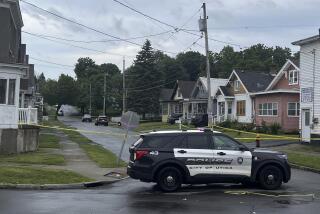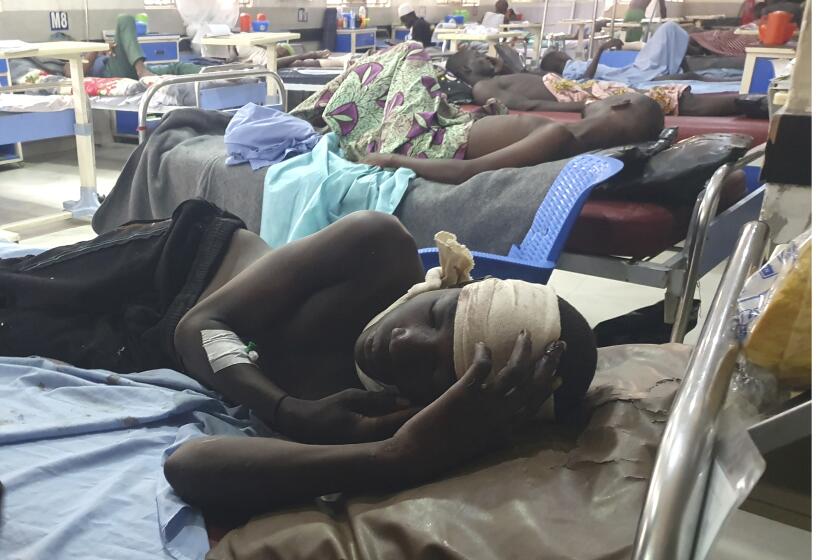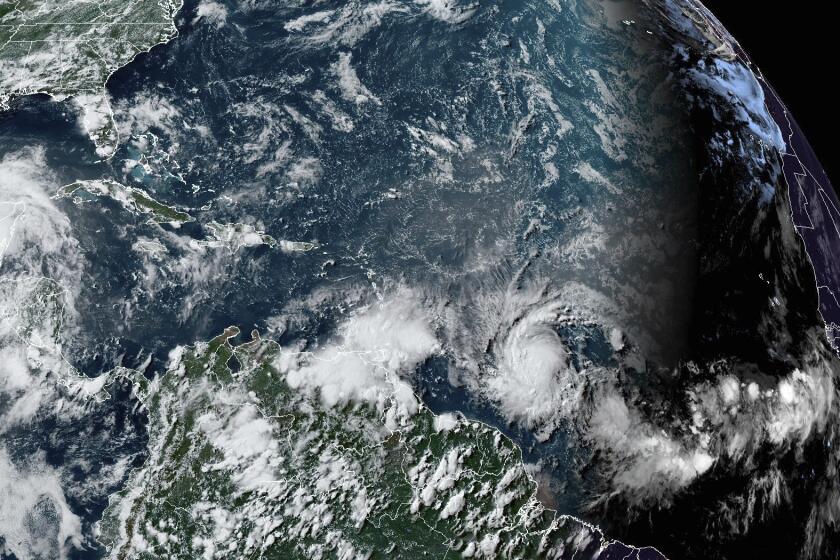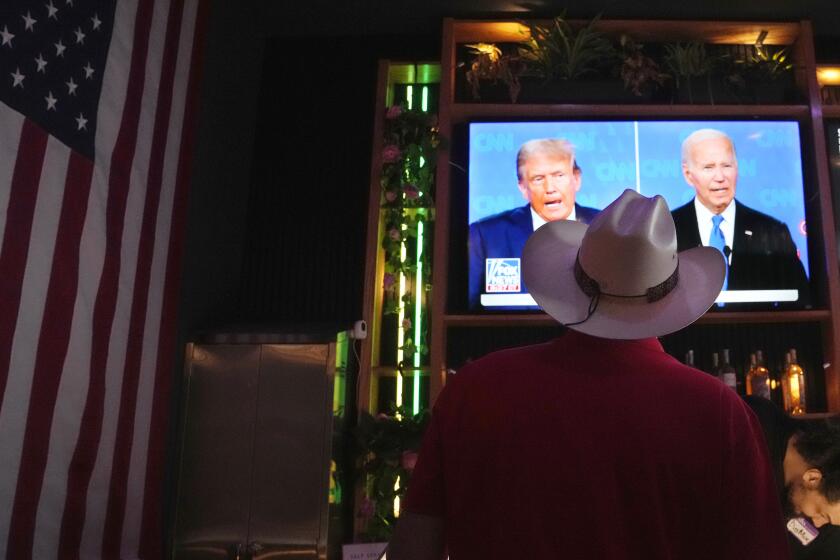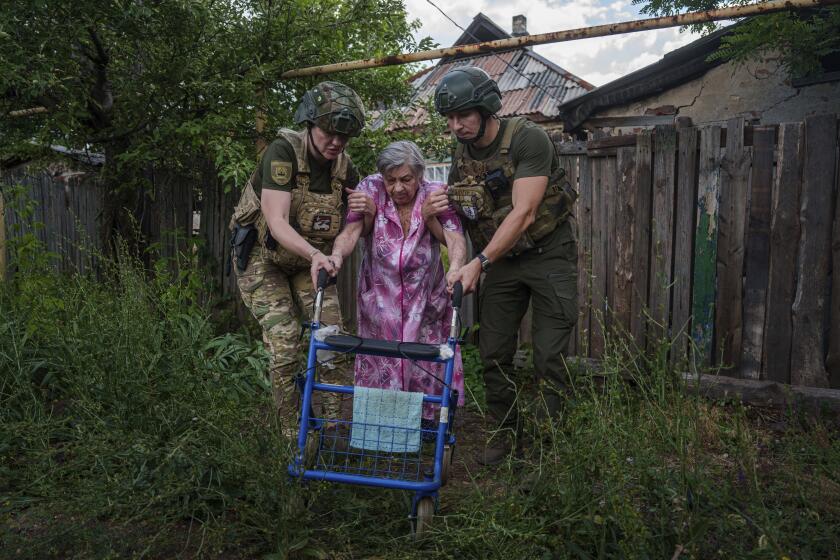Sense of Disorder, Impermanence : Managuans See Their City in a Jumble of Memories
There is a Managua that exists only in the minds of the people who live here.
To get around in Managua, one has to know that phantom city of the mind--as if it weren’t enough to have to deal with heat, floods, earthquakes, poor transportation and confusing geography.
Directions are given referring to buildings and other landmarks that disappeared long ago, in some cases so long ago that few people remain who ever saw them.
Looking for the embassy of Czechoslovakia? It stands across from “where the Teodolinda Mansion was.”
The ornate Teodolinda Mansion once graced a Managua street corner, but it collapsed in an earthquake and was never rebuilt. Yet virtually everyone still uses it as a reference point.
One may be told to proceed “from where the Pepsi-Cola factory was, two blocks to the lake and one below.” Never mind that there is now another Pepsi plant, in an altogether different location.
And there is “one block up and two south from where the little tree was.” The “little tree” was in fact a towering giant that died perhaps 40 years ago.
People everywhere use landmarks to orient themselves. But Managuans seem extraordinary in referring to places that no longer exist. No one knows why. “We just carry the places around in our minds,” a taxi driver said. “We do this even if we never knew them.”
Perhaps such a mental exercise helps Managuans fill in the many gaps in the city’s landscape. For Managua, capital of Sandinista-led Nicaragua, in part lacks physical existence.
Gertrude Stein, who wrote of Oakland, “there is no there there,” would have had a similar view of Managua.
Wheel With No Hub
Managua has been likened to a wheel without a hub or a doughnut, for it has no center. The city’s downtown perished in a devastating earthquake in 1972, leaving mostly scattered ruins and open fields where shops, homes and businesses once stood. Money was donated abroad for relief and reconstruction, but President Anastasio Somoza, the dictator of the period, is said to have appropriated much of it for his own use.
When the capital was located here in 1855, the site was a compromise choice between the rival cities of Granada and Leon. It is Managua’s bad luck that the site lies on a major earthquake fault. In 1931, an earthquake caused widespread damage, but no serious thought was given to moving the capital.
Today, the ruins of what used to be downtown Managua are a jumble of memories. The shell of the old cathedral stands on what was the city’s main plaza. Roman Catholic Church officials have asked permission to rebuild, but the leftist Sandinista government has turned them down.
The church hierarchy, a harsh critic of the Sandinistas, suggests that the government wants to discourage ideological competition in the plaza, which is also the site of the tomb of Carlos Fonseca Amador, one of the founding fathers of the Sandinista National Liberation Front.
A New Rallying Point
Not far from the main plaza is a new one, which the Sandinistas have laid out and landscaped as a place to conduct their Cuban-style mass rallies. The latest entry in what is becoming a collection of political memorabilia downtown is a giant metal statue of a laborer, rifle in one hand, pick in the other.
The city’s ruins have been put to a wide range of uses. Some are set aside for storage. In others, squatters have taken up residence. In what is left of the old Grand Hotel, a theater and modern art museum have been established.
There are some signs of an effort to replace what was destroyed. A new housing project of brightly colored apartments is creeping in on the western edge of the desolation. But Managua’s role as headquarters of a beleaguered leftist revolution has tended to emphasize the sense of disorder and impermanence.
Most abandoned buildings have been put to government use. Houses left behind by exiles have been confiscated and are now being used as offices. Military depots and the headquarters of burgeoning bureaucracies mingle with bungalows and auto repair shops.
Somoza Home Seized
A one-time mansion of the Somoza family now serves as headquarters for the nation’s electoral council. The house of Adolfo Calero, a leader of the U.S.-backed rightist rebels called contras, now is an entertainment center and conference site for foreign correspondents.
Revolutionary slogans are scrawled everywhere.
Managua suffers from problems common to many Third World countries and, according to the government, the inconveniences are aggravated by the counterrevolution, which is diverting resources to the military.
Whatever the reason, power outages are frequent and telephone service is uncertain. The phone company recently outraged subscribers by sending out old bills at new, higher rates.
In the hot rainy season, flooding turns some streets into rivers that rush into polluted Lake Managua. The torrents sometimes obscure ditches that lie in wait for unsuspecting motorists.
Transport Woes Abound
Buses are infrequent and overcrowded. Youths hang from the back door or perch precariously on top. Trying to wave down a taxi can be a long, exhausting exercise in futility.
Still, Managua’s shortcomings as a national capital have not discouraged rural people from coming to the city in search of an easier life. In the past six years, since the Sandinista revolution toppled the Somoza regime, Managua’s population has increased from 600,000 to 900,000.
New neighborhoods of squatters have sprung up. Managuans call the newcomers “parachutists” because they appear to have come from nowhere.
Like slums in other Latin American cities, these squatter barrios for the most part have neither running water nor electricity, although, in some of them, resourceful residents have tapped into power lines and water mains. Such improvisation has put added pressure on the city, which rations water during the dry season by cutting off the supply twice a week in different neighborhoods on a rotating schedule.
The water-rationing creates another problem: Sewage seeps into the depressurized water lines and causes health problems.
Politics Divides City
The city, like the country, is divided by politics. Some neighborhoods are pro-Sandinista and some are not so friendly toward the government.
Riguero, a working-class barrio, is often described as heroic in government pronouncements because of its history in fighting Somoza’s National Guard during the revolution. Riguero is characterized by a pro-government church with a mural that depicts a peasant carrying the cross.
Bello Horizonte, on the other hand, is a humble neighborhood of mixed political opinion. It is home to a church run by a priest who was once accused of trying to establish a network of saboteurs. He was set free after a brief period of house arrest.
Wealthier sections of the city have experienced a considerable changeover. Las Colinas, the wealthiest of all, is home to many anonymous foreign advisers who live in spacious homes abandoned by the Nicaraguan rich.
If Managua has a commercial heart, it is the Eastern Market, a labyrinth of shops operated by thousands of small-time entrepreneurs. The government calls them “speculators.”
Goods that are in short supply elsewhere turn up at the Eastern Market, and the Sandinistas therefore want control of the market. A police station has been set up there with the announced intention of cutting crime in the district, said to be 10% of all the crime in the country.
The city’s largest shopping center is called Plastic City, out of scorn for the aspirations of its middle-class clientele. A McDonald’s hamburger shop continues to do business there; at least it is still called McDonald’s. The golden arches are still in place, but the quarter-pounders consist of dry meat and white cheese.
Every so often, the government announces plans for developing Managua. One such plan suggested that the city should become self-sufficient, Marxist style, no longer dependent on the surrounding countryside for food and other needs. A monument to the plan is a large garden to grow vegetables.
There are plans too to clean up Lake Managua and reopen an elegant cultural center downtown, but these have been put aside for lack of money. The bad news came from the Finance Ministry, which stands two blocks south of where the Alcazar Theater used to be--wherever that is.
More to Read
Start your day right
Sign up for Essential California for news, features and recommendations from the L.A. Times and beyond in your inbox six days a week.
You may occasionally receive promotional content from the Los Angeles Times.

